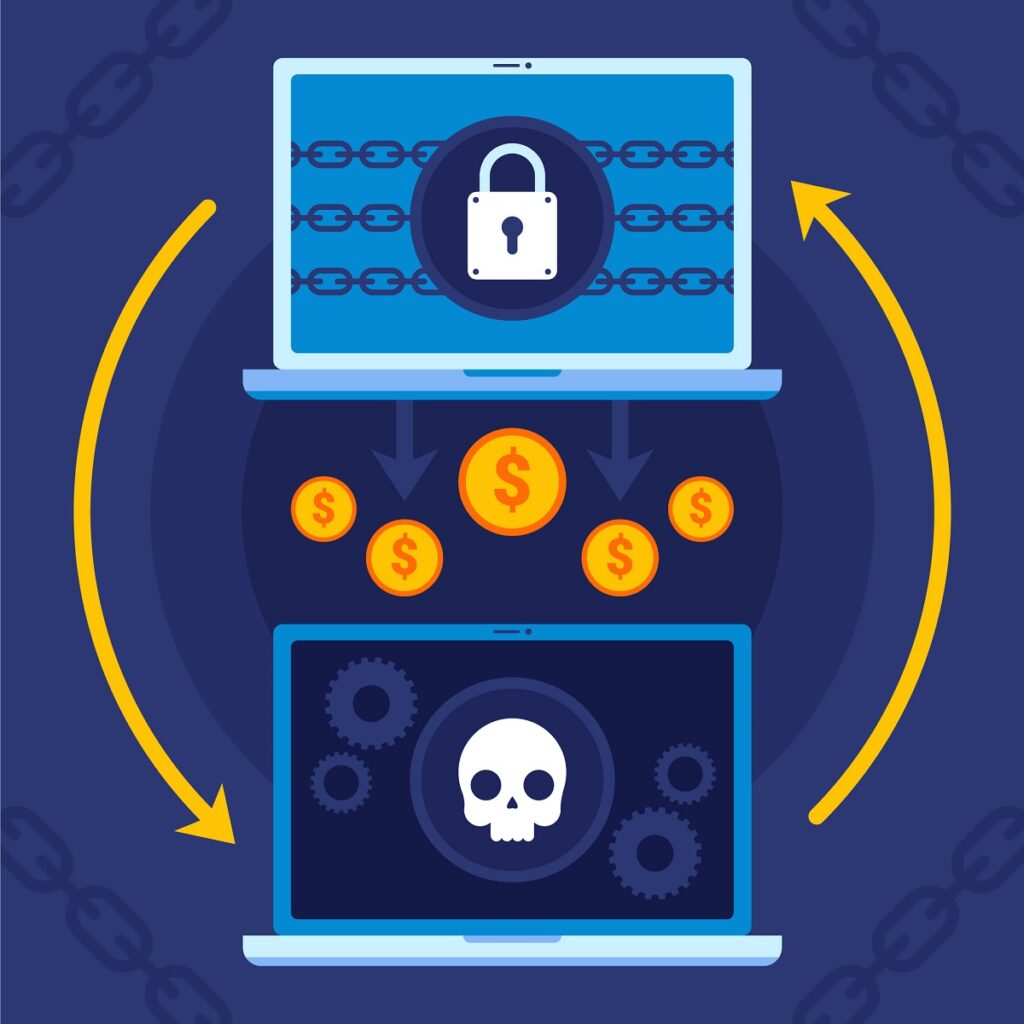When ransomware strikes, the impact is immediate: locked files, interrupted activity and a daunting ransom message on your screens…
This worrying situation nevertheless offers several avenues for resolution.
Here, we present effective methods for recovering your data after a ransomware attack, without necessarily giving in to the cybercriminals’ demands.
Our experts have compiled concrete solutions, based on years of experience in handling such incidents, to help you restore your systems and strengthen your IT security to prevent future compromises.
Table des matières
ToggleHow widespread is the ransomware threat?
Unfortunately, ransomware attacks are no longer the exclusive preserve of large corporations or government institutions.
In fact, no one is immune to this threat, which has become tragically democratized. This malware is designed with a simple but devastating objective in mind: to encrypt your data and systems and extort a ransom in exchange for decrypting them.
As a result, the impact is usually catastrophic: complete shutdown of operations, potential loss of critical data, damage to reputation, not to mention direct financial consequences that can run into millions of euros for large organizations. For SMEs, these attacks can simply mean the end of business.

Ransomware: a multi-faceted threat
The ransomware landscape is constantly evolving, but we can distinguish several main categories that we regularly encounter in our practice:
Encryption ransomware remains the most widespread. Variants such as CL0p, Quilin, Ryuk, or the historic WannaCry turn your documents, images and databases into unreadable files, usually with the .encrypted extension or a signature specific to the malware strain.
Locker ransomware goes a step further, completely blocking access to the operating system. You’re faced with a lock screen that’s impossible to bypass, often with a daunting countdown timer. WinLocker is one of the earliest examples of lockout ransomware.
Double extortion represents a particularly pernicious evolution we’ve been observing since 2019.
Not content with encrypting your data, attackers exfiltrate it beforehand and threaten to disclose it publicly if you don’t pay. This technique puts additional pressure, particularly for organizations subject to the RGPD or handling sensitive data. Akira, Inc Ransom, Quilin, Fog… all exemplify this practice.
The RaaS (Ransomware-as-a-Service) model has unfortunately industrialized this threat, enabling individuals with no advanced technical skills to acquire these destructive tools on the darknet, in return for a subscription or profit-sharing. This model is becoming increasingly important in the ransomware landscape: Lynk, Medusa, FunkSec, etc. are just a few examples.
See our page dedicated to ransomware groups
What to do immediately after a ransomware attack?
In the first few hours after an attack is detected, the countdown begins and every minute counts. Our experts have established an emergency protocol that maximizes your chances of recovery:
Isolate to contain
Your first action should be tophysically isolate infected systems. Disconnect network cables, disable Wi-Fi, and if necessary, switch off adjacent equipment to prevent horizontal spread of the ransomware. This measure is often difficult to take because of the disruption it causes, but it is absolutely essential.
Preserve digital evidence
Before any recovery attempt, scrupulously document the incident. Capture images of the ransom note, note the extensions of encrypted files, and keep system logs if you have access to them.
These elements will be invaluable in identifying the ransomware variant, and could prove decisive for recovery as well as for any legal investigation.
Avoid hasty action
In a panic, certain instinctive reactions can irreparably worsen the situation.
Never try to format your infected systems: this action would definitively destroy any hope of recovery without a decryption key. Similarly, consumer recovery tools are generally ineffective against sophisticated encryption algorithms, and risk further damaging your data.
Contact specialized experts
In this type of attack, time wasted in trial and error can prove fatal to your data.
Contact a specialized service like SOS Ransomware immediately. Our crisis team is available 24/7 to guide you through these critical moments and deploy the appropriate countermeasures. We’re ready to support you in these moments of crisis. We help you stay one step ahead of your attackers…
Ransomware recovery services: an alternative to payment
Contrary to popular belief, paying the ransom is neither the only nor necessarily the best option.
In our experience, around 30% of companies that pay never get a working key, or receive a faulty decryptor that further damages their data. Not to mention that payment directly funds future attacks and marks your organization as a “paying” target for future assaults.

How do professional recovery services work?
Services like SOS Ransomware rely on several technical approaches to restore your data without paying a ransom:
The use ofspecific decryption tools developed by the security community or by our laboratories to counter known ransomware variants, or develop new tools.
These keys sometimes exist as a result of design errors by cybercriminals, or after the authorities have seized their servers.
Data reconstruction techniques that exploit the characteristics of file systems to recover unencrypted fragments or earlier versions of files. SOS Ransomware uses advanced techniques to recover data, even in complex situations, depending on the systems and backup tools used. Here’s how we do it:
- Synology NAS systems: In particular, we specialize in recovering Hyper Backup (HBK) backups and restoring data stored on RAID systems, even after deletion or formatting.
- Veeam, Acronis and Arcservebackups: Our tools repair damaged backup files and extract essential data, such as virtual machines or critical files.
- Databases: We recover SQL, Oracle and other databases, rebuilding their structures to ensure their integrity and functionality.
- Virtual machines: We restore damaged or encrypted virtual machines (VMware, Hyper-V) so that they are operational again.
- RAID systems: We repair RAID configurations (RAID 5/6) to recover lost data even when several disks are affected.
These techniques are based on in-depth analysis of file systems and backups, and on specialized tools developed by our teams. Whether your data is on a server, a NAS system or in a virtual machine, we do our utmost to recover it quickly and efficiently.
Reverse engineering of the algorithms used by ransomware can sometimes reveal cryptographic weaknesses that can be exploited to reconstitute keys. This highly specialized work is carried out in our secure laboratories.
Comprehensive forensic analysis enables us not only to identify attack vectors, but also to recover unencrypted data that may remain in unallocated disk sectors or temporary memory. This method stems from our long history in the data recovery sector.

Why choose SOS Ransomware?
The SOS Ransomware methodology: precision and efficiency
When a customer contacts us after an attack, our first action is always an audit of the incident. This preliminary step enables us toaccurately identify the type of ransomware that has struck, and to assess the true extent of the damage. It is on this solid basis that we build our intervention strategy.
Unlike many market players, we don’t just use off-the-shelf tools. Our team has developed proprietary solutions specifically designed for the different ransomware families we encounter. These tools often give us the decisive edge when it comes to decrypting files that others would consider lost.
Security remains our top priority throughout the process. We immediately isolate affected systems to prevent any propagation, and handle your backups with extreme care. This methodical approach has enabled us to avoid secondary contamination, which often complicates recovery attempts.
We can intervene remotely, on site, or in our laboratories.
What data can we recover?
The scope of our expertise covers virtually all professional IT environments. We intervene daily on complex databases, sophisticated RAID architectures and all types of networked storage solutions (NAS, DAS, SAN).
Virtualized environments account for a growing proportion of our interventions, with successful recoveries of mission-critical virtual servers and compromised backup systems. Whether you’re a private company with strategic files, or a public authority managing sensitive documents, our approach adapts to the specific nature of your data.
Your quality assurance: verification and security
Recovery is only part of our mission. Every restored file goes through a rigorous quality control process to guarantee its integrity. We don’t just give you back data – we give you back reliable, usable data.
We use the SFTP protocol exclusively for restoration, offering the highest level of security during transfer. This final step is often overlooked by other service providers, but is fundamental to truly secure end-to-end recovery.
Why our customers choose us
Over 20 years’ experience in complex data recovery has enabled us to achieve a success rate of over 80% in data recovery, even in situations considered hopeless by other experts.
This performance is due in no small part to our constant investment in technological innovation. Our laboratories are constantly developing specialized tools that enable us to respond effectively to the latest ransomware variants.
We understand the urgency of a ransomware attack. That’s why our team is available 24 hours a day, ready to develop a customized solution to meet your exact needs, whether you’re an SME, a major corporation or a public institution.
Finally, there’s the economic aspect: our services generally represent an investment 2 to 10 times lower than a ransomware charge. Not to mention that by paying a ransom, you have no guarantee of recovering your data, and you’re encouraging a criminal ecosystem.
By choosing SOS Ransomware, you are opting for an ethical, efficient and cost-effective solution that will not only help you overcome the current crisis, but also strengthen your resilience in the face of future threats.
Beyond recovery: preventing future attacks
While our primary mission is to help you recover your data, we don’t stop there. The experience of an attack should serve as a catalyst to reinforce your security posture in the long term.
The vital importance of backups
Backup strategy remains your best defense against ransomware. We strongly recommend adopting the 3-2-1 principle: three copies of your data, on two different types of media, including one off-site copy. But beware: backups permanently connected to your network can also be encrypted during an attack. The most effective solutions include immutable backups that cannot be modified or deleted for a defined period.
Reinforcing your infrastructure
In the aftermath of an attack, it is essential to put in place reinforced defensive measures:
- Deployment of EDR (Endpoint Detection and Response) solutions rather than traditional antivirus software
- Network segmentation to limit horizontal propagation
- Implementation of least privilege and multi-factor authentication policies
- Tougher configuration of servers and workstations
- etc
Training and awareness
People remain the central link in any cybersecurity strategy. Following awareness programs adapted to your corporate context, including phishing attack simulations and practical exercises to develop appropriate reflexes in the face of intrusion attempts, is part of the right reflexes.
Incident response plans
A well-functioning incident response plan can drastically reduce the impact of an attack. Developing and regularly testing these procedures to ensure a rapid and effective response to a crisis, with clearly defined roles and alternative communication channels, can prove beneficial.
Choosing the right recovery partner
With so many anti-ransomware services on offer, how can you tell which providers are truly capable of helping you? Here are the essential criteria to consider:
Proven expertise
Check the service provider’s track record and references. How many years’ experience does it have in specific ransomware recovery? Can they share anonymized case studies demonstrating their ability to handle situations similar to yours?
Transparency of results
A serious service provider like SOS Ransomware clearly communicates its success rates and the limits of its interventions. Beware of promises of 100% guaranteed recovery, which are generally misleading marketing.
Contractual guarantees
The “No recovery, no charge” formula we offer demonstrates our confidence in our capabilities, and protects you from a second financial loss should recovery prove impossible.
Conclusion
Ransomware attacks represent one of the most serious threats facing organizations today. Yet even in the face of this seemingly hopeless situation, solutions do exist.
Specialized services like SOS Ransomware offer a credible alternative to paying ransom, with high success rates and an approach that doesn’t just restore your data, but helps you rebuild a more resilient environment.
If your organization is under attack, remember that every minute counts. Contact the experts immediately to maximize your chances of recovery and minimize the operational impact. Our team is on call 24/7 to support you at this critical time.
